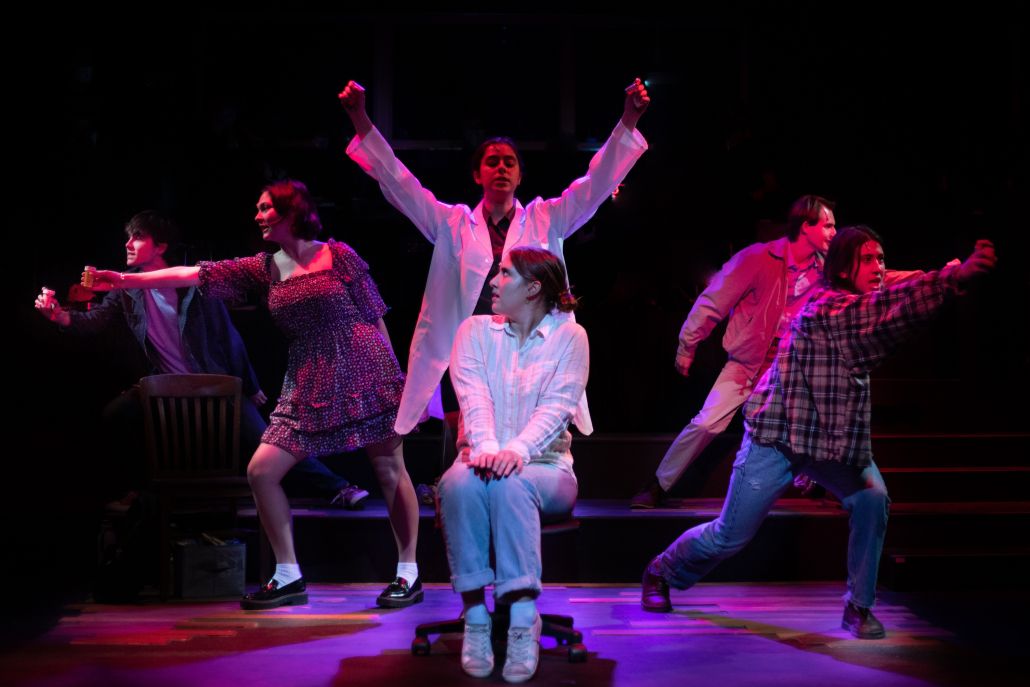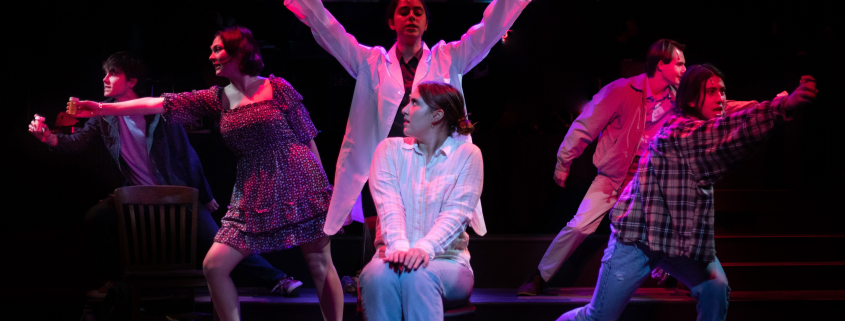An independent student musical sends a message

Content warning: This article contains references to bipolar disorder
In the theatre world, it’s somewhat of a commandment that there are no small roles. This has never been truer than with Musical Theater Repertory’s production of “Next to Normal” — although its cast is comprised of only six people, it took dozens working behind the scenes to bring it to life.
An independent theater company at USC, MTR showcases student-run productions every semester. Its latest venture, a production of the 2009 American rock musical, premiered Thursday at Massman Theatre.
At the tail end of a five-week rehearsal process, MTR board members and crew heads began planning the show in December. Production manager Erica Ammerman, a junior majoring in theatre, said audiences often don’t realize how much behind-the-scenes work goes into a successful stage production.
“Before the actors even walked into the theater, there have been designers there [for] hours upon hours upon hours, up and down ladders, hanging lights, circuiting them, building, painting — and that’s all just as vital to telling the story,” Ammerman said.
“Next to Normal” tells the story of Diana Goodman, a suburban mother whose severe bipolar disorder brings severe hardship to her life and the lives of her family members. The show tackles heavy and meaningful themes of depression, grief, suicide and drug abuse.
The MTR team has worked not only to ensure that the story is told with authenticity and dimension, but that the cast and crew take care of their own mental health throughout production, Nico Fife, the director of the production, said.
“It was one of the priorities of not only myself, but my assistant director and my music directors, that we never wanted the performers, the designers or anyone working on this to go to an unsafe place while working,” said Fife, a senior majoring in theatre with an acting emphasis.
Tali Green, the actress playing Diana, said that the attention to team well-being had been a focus since the beginning of the rehearsal process. She also said the cast did a meditative “step-in” at the start of every rehearsal and a “step-out” at the end so that they wouldn’t carry the show’s somber subject matter home with them.
“We’re stepping into the show, we’re stepping into our characters and, at the end, no matter what happens — what text we covered, what scenes we blocked, what happened — we can step out and separate our lives from the characters’ lives so that we’re not going home feeling sad and emotional,” said Green, a senior majoring in theatre.
To help the cast and crew gain a deeper understanding of the show’s narrative, MTR brought on Emiko Ohta, a freshman majoring in cognitive science and theatre with an acting emphasis, as their dramaturge. In their dramaturge role, Ohta conducted outside research and helped answer the cast and crew contextual, historical or thematic questions about the script.
“It’s a lot of researching and collaboration,” Ohta said. “It’s a lot of being inquisitive all the time and taking a really deep look into the script, songs and themes of the show, and really breaking it down bit by bit to make sure whatever we put on is the most authentic, real and engaging to the audience and actors.”
Ohta also said the team planned to include an audience dramaturgy packet to offer a condensed version of the research conducted during the rehearsal process, as well as resources and references connected to the show’s topics.
The technical aspects of “Next to Normal” also play a part in delivering its emotional message. Jacob Hollens, the show’s lighting designer, said they spent time reflecting on the representation of different characters through colored lighting.
“[The] colors I’ve chosen have very specific intentions,” said Hollens, a freshman majoring in theatre design. “Oftentimes, you’ll see a repetition of a certain color and a certain theme, and it’s supposed to match with each different element that I’m trying to emphasize in a certain song.”
But the road to opening wasn’t without its bumps: one actor took a leave of absence during the rehearsal process and was replaced by Ryan Myers, a senior majoring in theatre. Despite having less than two weeks to learn his part, Myers rose to the challenge, learning all of his lines, music and blocking and developing chemistry with his fellow actors, Fife said.
Because “Next to Normal” is Fife’s directorial debut, he said he went in with an expectation of what the show would be and has faced difficulty accepting technical roadblocks that challenged his initial vision. Ultimately, he said the final product did not meet what he imagined — it exceeded it.
“What I thought the show was going to be three months ago when I first pitched it and we were putting together the team, is nothing like what the show is going to be when it opens, but in the best way,” Fife said. “It is infinitely better than I could have imagined and the team has brought so much new life to it.”
“Next to Normal” has four remaining showtimes: Friday at 10:30 p.m., Saturday at 8 p.m. and both Saturday and Sunday at 2:30 p.m.

